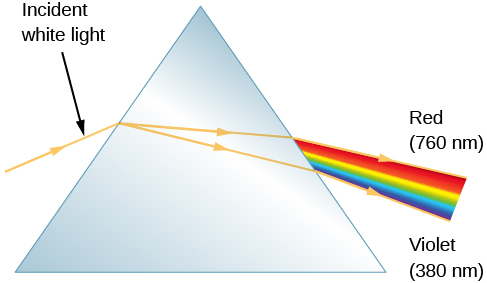| << Chapter < Page | Chapter >> Page > |
By the end of this section, you will be able to:
Electromagnetic radiation carries a lot of information about the nature of stars and other astronomical objects. To extract this information, however, astronomers must be able to study the amounts of energy we receive at different wavelengths of light in fine detail. Let’s examine how we can do this and what we can learn.
Light exhibits certain behaviors that are important to the design of telescopes and other instruments. For example, light can be reflected from a surface. If the surface is smooth and shiny, as with a mirror, the direction of the reflected light beam can be calculated accurately from knowledge of the shape of the reflecting surface. Light is also bent, or refracted , when it passes from one kind of transparent material into another—say, from the air into a glass lens.
Reflection and refraction of light are the basic properties that make possible all optical instruments (devices that help us to see things better)—from eyeglasses to giant astronomical telescopes. Such instruments are generally combinations of glass lenses, which bend light according to the principles of refraction, and curved mirrors, which depend on the properties of reflection. Small optical devices, such as eyeglasses or binoculars, generally use lenses, whereas large telescopes depend almost entirely on mirrors for their main optical elements. We will discuss astronomical instruments and their uses more fully in Astronomical Instruments . For now, we turn to another behavior of light, one that is essential for the decoding of light.
In 1672, in the first paper that he submitted to the Royal Society, Sir Isaac Newton described an experiment in which he permitted sunlight to pass through a small hole and then through a prism. Newton found that sunlight, which looks white to us, is actually made up of a mixture of all the colors of the rainbow ( [link] ).

[link] shows how light is separated into different colors with a prism—a piece of glass in the shape of a triangle with refracting surfaces. Upon entering one face of the prism, the path of the light is refracted (bent), but not all of the colors are bent by the same amount. The bending of the beam depends on the wavelength of the light as well as the properties of the material, and as a result, different wavelengths (or colors of light) are bent by different amounts and therefore follow slightly different paths through the prism. The violet light is bent more than the red. This phenomenon is called dispersion and explains Newton’s rainbow experiment.
Upon leaving the opposite face of the prism, the light is bent again and further dispersed. If the light leaving the prism is focused on a screen, the different wavelengths or colors that make up white light are lined up side by side just like a rainbow ( [link] ). (In fact, a rainbow is formed by the dispersion of light though raindrops; see The Rainbow feature box.) Because this array of colors is a spectrum of light, the instrument used to disperse the light and form the spectrum is called a spectrometer .

Notification Switch
Would you like to follow the 'Astronomy' conversation and receive update notifications?